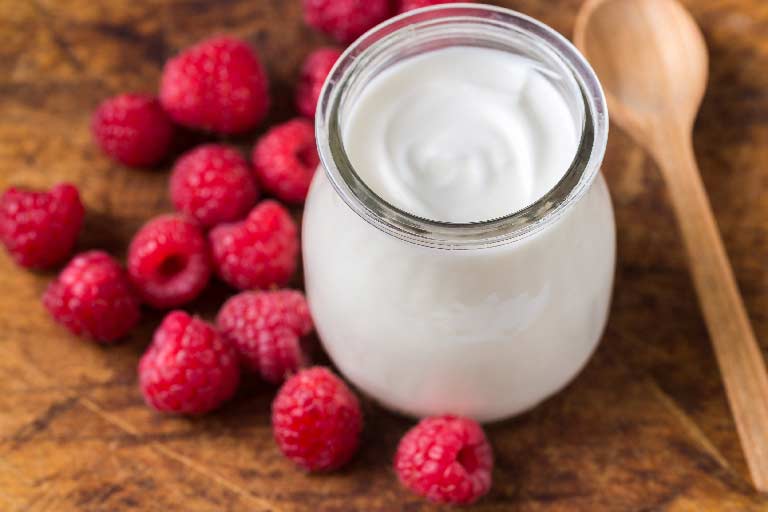Yogurt

How many foods can claim that they are a creamy, delicious treat, chock full of nutrients, and might just improve your health and prolong your life? Well, here’s one, known from its earliest days as “food of the gods”: yogurt.
This dietary staple, the story goes, came about accidentally in about 6,000 BC in Central Asia. Native herdsman, having discovered the concept of milking animals for sustenance, had taken to toting the milk from place to place in bags made of animal stomachs, the preferred receptacle for a variety of things. The warm climate and the enzymes present in the stomachs caused the milk to curdle, serving to both preserve it and give it a pleasing flavor and appealing curd-like texture. The Roman naturalist and author Pliny the Elder later described the process as “thicken(ing) the milk into a substance with an agreeable acidity.” The term “yogurt” comes from the Turkish yogurmak, meaning “to be curdled or coagulated; to thicken,” and for a product to be officially labeled as such, it must contain two living bacteria strains (also known as probiotics or “active cultures”): streptococcus thermophiles and lactobacillus bulgaricus. (It just rolls off the tongue, doesn’t it?)
Yogurt’s health benefits received a significant public relations boost in Western Europe when, in 1542, the French king François I, suffering from a heretofore incurable case of severe diarrhea, saw his health miraculously improve after his friend Suleiman the Magnificent, Sultan of the Ottoman Empire, sent a doctor who recommended consuming yogurt. This high-visibility success, along with the news that other yogurt aficionados (in particular, Bulgarian peasants) were enjoying remarkable longevity (and fertility), caused its popularity to spread throughout Europe and beyond. It is rumored that Genghis Khan and his Mongol army ate yogurt extensively, believing that it boosted their strength and stamina.
How did yogurt become a commercial, mass-produced product? For the answer, we go to Barcelona, Spain shortly after World War I; a man named Isaac Carasso started a small yogurt-making concern that he named after his young son, calling it Danone (“little Daniel”), later expanding the business to France. After the brand was brought to the U.S. in 1942 by a now-grown Daniel Carasso, the name was Americanized to Dannon; this marked the beginning of yogurt’s real popularity in America, more than two centuries after its tepid introduction here by Turkish immigrants. Five years later, Dannon began adding “fruit on the bottom” to its yogurt (the first: strawberries), more than a decade after a dairy in Prague incorporated jam into its yogurt.
As the health food craze took hold in the 1950s and 60s, the yogurt industry exploded, with more and more flavors and textures making their way to the marketplace. Frozen yogurt (or “froyo”) came along in the 1970s in response to demand for a healthy alternative to ice cream. Early efforts were not too successful (because the taste was far more “yogurt” than “ice cream”), but Dannon came up with a frozen fruit-flavored yogurt “popsicle” they called “Danny,” and a few years later, TCBY (This Can’t Be Yogurt and later, after some threatened litigation, The Country’s Best Yogurt) introduced the soft-serve variety, with the option to add your own toppings. Frozen yogurt has been popular ever since.
Here are some other fun facts:
- Which countries consume the most yogurt? France, followed by Turkey. 57 percent of French citizens eat yogurt each day, with Turkey close behind at 52 percent. In general, Europeans consume about 40 pounds per year, mostly in the afternoon and evening. Other big yogurt consumers: Germany, Ireland, Canada, Great Britain, Brazil, Australia, and Indonesia.
- Where do Americans fall on the yogurt-eating spectrum? At about 13 pounds annually, per capita (in the aggregate, about 300,000 tons), with 20 percent of Americans enjoying yogurt daily…usually for breakfast.
- America’s most popular yogurt flavors, in order, are strawberry, vanilla, plain, peach, blueberry, raspberry, cherry, and mixed berry.
- Plain Greek yogurt (yogurt that has been strained to remove its excess liquid whey) is a satisfactory lower-fat substitute in recipes that call for mayonnaise or sour cream, especially in the Mediterranean and countries in the Persian Gulf. More than a third of yogurt sold in U.S. grocery stores is the Greek variety.
- Women are far more likely to eat yogurt than men; marketers are working hard to change that with more “manly” packaging designs.
- If you would rather not eat yogurt, it makes an effective, economical skin treatment — a few tablespoons applied to the face as a mask will serve as an exfoliant, promote skin renewal, and reduce inflammation and acne. (Hint: yogurt is also a great agent for cleaning brass.)
So, yogurt makes a great breakfast, helps prevent osteoporosis, alleviates intestinal maladies, promotes clear skin, strengthens bones and teeth, boosts energy, makes your brass fixtures shine, and is a low-fat, tasty treat. What’s not to like?





